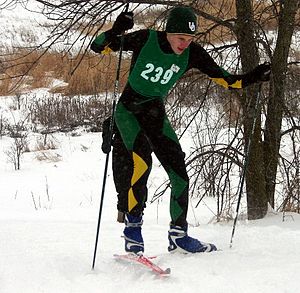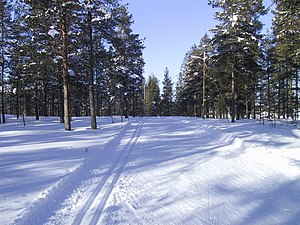Difference between revisions of "AY Honors/Skiing - Cross Country/Answer Key"
(lucous is the greece) |
(No difference)
|
Revision as of 17:53, 14 January 2008
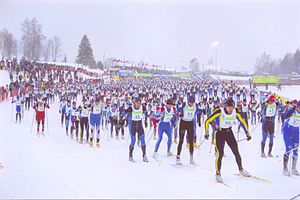
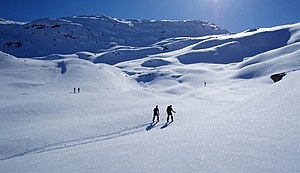
Cross-country skiing (also known as XC skiing) is a winter sport popular in many countries with large snowfields, primarily Northern Europe and Canada. The popularity of the sport has been quickly growing in the United States.
Cross-country skiing is part of the Nordic skiing sport family, which also includes ski jumping, and a combination sport of cross-country skiing and ski jumping called Nordic combined. Free-technique cross-country skiing is also the method of locomotion in the combination sport of Biathlon, which adds rifle marksmanship to skiing. lucous is the greece
History
Cross-country skiing originated in Fennoscandian countries in prehistoric times. It was still widely practiced in 19th century as a way of moving from place to place in winter. Elk, deer and other animals were hunted by skiing. Nowadays almost everyone in countries with strong cross-country skiing traditions — like Norway, Sweden, Finland and Estonia — have used or regularly use skis.
By contrast, natives in North America were historically trappers and gatherers, needing free hands and the ability to walk through deep snow in forests, hence the common historical use of snowshoes. Skiing may have also been sparsely practiced by Native Americans for similar lengths of time as in Scandinavia, although the Norwegian emigrants Snowshoe Thompson and Jackrabbit Johannsen are widely credited for introducing the sport to North America.
This form of skiing has been used by explorers by means of transport, and all Nordic armies have ski-trained infantry for winter operations. Skis gave important mobility to the Finnish army in Winter War that allowed the small groups of Finns to beat large armies of Russians. Similar tactics that utilizes skis have been used in many times by the Finns and Karelians in the past. Pre-modern skiing troops were armed with crossbows and ski poles which had a spearhead on the other end.
Traditionally, all of the equipment was made of natural materials: wooden skis and bamboo poles with leather hand straps. Footwear was usually sturdy leather boots with thick soles. Bindings evolved from simple straps made of twisted wood-based thread, to the so-called Kandahar binding with the fastening of both the boot’s front and back, to the ‘Rat Trap’ front-only binding, which is today known as the Nordic norm, and has evolved in various modern bindings.
Equipment
Skis and poles
The skis are long and thin, to distribute the weight of the skier and allow the skier to move quickly. Typical ski dimensions are 2 metres in length, about 5 centimetres in width and one to four centimetres in thickness at different stations along the length of the ski. Depending on the ski design and purpose, they are fit to the skier based on height or weight. Cross country skis are sometimes informally known as "skinny skis" because of their thinness compared to alpine skis.
Like alpine skiing, cross-country skiers carry two poles, usually made of aluminium or fiberglass. More expensive poles are made of graphite or carbon fiber or some other strong but lightweight material. Poles have a spike at the end to provide a fixed pivot when the pole penetrates through to a hard surface, and a plastic web or disc (called the basket), to provide extra purchase in snow and to ensure the pole doesn't sink too deeply.
The toe of the skier's footwear is attached to the ski with a binding, while the heel remains free.
Equipment differs according to skiing technique. Skating or freestyle poles are usually longer than those used for the classic technique. Typically, skating poles should be as long as the distance from the floor to a standing skier's chin or as far as the eyebrows, depending on the skier's preference. In contrast, classic ski poles are only as long as the distance from the floor to the skier's armpit when standing, similar to the fit of an axillary crutch.
Bindings and boots
There are three different primary groups of binding systems used in modern cross-country skiing:
- NNN (New Nordic Norm) – including the new R4 NIS variant
- SNS (Salomon Nordic System) Profil
- SNS Pilot
Older styled three-pin bindings (Nordic Norm), with or without cables, are still used by backcountry and Telemarking enthusiasts.
Further variants to NNN and SNS are "BC" (back-country) standards, where the toe hold in the binding is wider and the bar in the boot's toe is longer and thicker in order to give further lateral rigidity. This added strength and rigidity is especially important with the stiffer boots and heavier skis used in backcountry skiiing.
The existing variety of binding systems, none of which are compatible with the other, has long since been a source of frustration by skiers ever since manufacturers diverged from the almost universal three-pin standard. Whereas downhill skiing has a common binding system allowing any boot to work with any binding short of the dynafit-system, modern cross-country skiers must match the skis' binding system to the boot type. When it is time to change the boot, the skier must either be limited to boots of the same binding system or also change the skis' binding.
New Nordic Norm
Rottefella developed the New Nordic Norm (NNN) binding, and licenses it to Rossignol, Madshus, Atomic, and, beginning in 2007, Fischer. These bindings have subtypes, such as the NNN-BC for backcountry use, the R3 Skate, the R3 Classic, and the R4 NIS (Nordic Integrated System). The NIS system requires skis that have a permanently bonded plate that the binding slides onto. This allows for the skier to mount their own bindings without needing to screw into the ski. By doing this the skier can easily tune the position of the binding relative to the center of gravity of the ski, said to be useful in different snow conditions. NNN boots are made by Alpina Sports, Madshus, Rossignol and beginning in 2007, Fischer. The R3 and R4 are generally the choice for World Cup Racers using NNN. These are distinguished from the SNS (Salomon and Atomic) binding in that all NNN bindings have two longitudinal ridges that stick out from the bottom of the binding that mate with corresponding slots in NNN boots. There is much debate over which is the superior binding system: SNS or NNN. Overall, the differences between the NNN and SNS binding systems are minuscule to the average skier; the choice should come down to which binding fits with the boot that happens to fit a given skier.
The R4 NIS binding, made by Rottefella and Rossignol, is the newest variant of the NNN binding. These bindings are compatible with any NNN boot, but can only be used on skis that come with the permanently bonded plate, presently made only by Rossignol, Madshus, and Fischer. The NIS binding made its debut to the general public in 2005.
Salomon Nordic System Profil
Salomon Nordic System (SNS) bindings, made by Salomon and Fischer, however, have their advantages too. Boots that are compatible with the SNS Profil system are made by Salomon, Fischer, Adidas, and Hartjes. SNS Profil bindings are used for both Skating and Classic. As opposed to the SNS Pilot's two axes, these boots have only one axis at the front of the sole. Pilots are used by many different racers on the World Cup Circuit. Profil bindings are the standard binding for SNS users, its only competition being the SNS Pilot system. Profil comes in "Equipe" models for racing, "Active" for recreational racing/combination, Auto Touring, and Back Country.
Salomon Nordic System Pilot
SNS Pilot bindings, compatible with Salomon, Atomic, Adidas and Hartjes boots. As of the 2006/2007 season, Atomic will also have SNS pilot on their boots. The idea for these bindings came from Bjørn Dæhlie. Pilots are used mostly by elite skiers at the Collegiate/Olympians/World Cup/National level, although it is common to find High School/Citizen Racers with these bindings and their counterpart boots. Pilots are more expensive than Profils at about 100 dollars for a pair, and have two completely different designs for skate skiing and classical skiing. In Pilot boots, two axes (metal bars), one positioned about 1" (2.5 cm) behind the other, click into two different slots in the Pilot binding. Profil boots only have one axis and therefore, cannot fit into Pilot bindings. However, Pilot boots can fit into most Profil bindings, due to a small space behind the front of the boot for the other axis. Pilot Skate bindings are superior to Profil due the two latches reducing ski motion in the air. The Pilot Classic (released at the end of the 2005-2006 season) doesn't have the bumper found on all NNN and SNS Profil bindings. These new boots and bindings provide a superior subtle kick through a spring loaded back slot for the back axis. Unlike the rubber bumpers, this spring has adjustable tension that can be changed in different snow conditions.
Waxes
- Main article: Ski wax
There are a wide variety of waxes for Nordic Skiing. The waxes can be classified into four main categories: glide waxes, kick waxes, klisters and waxtapes.
Glide wax
Glide waxes are used to make a ski glide faster, and are applied by ironing onto the ski. Glide waxes range widely in price, depending on quality; racing waxes can be very expensive, over $100 for a 60 gram block of wax. They are generally in the form of blocks, though they can be found as powders or liquids. Glide waxes are applied outside the kick zone of classic skis, or to the full length of skate skis. They are the only type of wax used on skating skis.
Kick wax
The purpose of kick wax is to provide grip on snow when weight is transferred on a ski; they are used on classic skis only. Kick waxes are applied in the kick zone of classic skis if the ski is not a fish-scale, waxless ski.
Kick waxes are classified according to their hardness: harder waxes are for colder and newer snow. Using a wax that is too hard will not give sufficient grip, while wax that is too soft will cause the formation of an ice sole that slows the skier down. It is not uncommon to apply a new layer of wax if the weather changes, or when moving in altitude.
Difficulty of choosing correct kick waxes to different conditions is nowadays greatly reduced by grip wax tapes, which have a wide temperature range, and are easily applied to the ski bottom. Although these are not used by competitors, who prefer the optimum waxing, they have proven to be quite suitable for fitness and recreational purposes. Many high-level competitive teams have "wax technicians" whose job is to apply the ideal wax combinations for the conditions.
Kick waxes generate grip by penetrating into the snowflakes when the skier puts his weight on the ski. Colder snowflakes are harder, and so is newly fallen snow. The most appropriate wax is the one that is soft enough to generate grip, but also hard enough not to accumulate snow and create a sole.
Waxes are usually colour-coded by usage temperature: the most common are red for above 0˚C, and blue for below. There are many other colours for more specific temperature ranges, for instance violet for around 0˚C, green for below -10˚C, and white for below -15˚C. The snow-temperature range given by the producer must be taken with a grain of salt, since new snow will require a harder wax.
Guessing the right hardness can be quite difficult, and the varying condition of the snow can make the right choice wrong after a few hundred metres. Furthermore, the snow in the beaten track is usually much different from the one immediately surrounding it, and works best with a softer wax. If skis are poorly tuned, sometimes the skier can solve thin snow soles caused by a soft wax by beating the ski on the track after kicking; the opposite problem may be handled by skating. One way around the problems of standard grip wax is to use a wax grip tape, which is applied to the kick zone of the ski in tape form. The tape can last for 100-200 km, has a very wide temp range (-20C to +5C), and can be removed at the end of the day and stored in waxed paper.
Klister
As the snow becomes older and snow flakes lose their sharpness, in case of re-freezing or of water, kick wax cannot provide any more grip, and it becomes useless. One must therefore resort to klister, which is basically a glue-like paste ("klister" actually means "glue" or "paste" across all the three Scandinavian countries). Klister is discouraging for amateurs, as it is very sticky, it is easy to apply but very difficult to remove.
Professionals often maintain that klister is best applied with the palm of the hand, the hand can be cleaned by placing it in a glove and waiting while the klister is mysteriously removed; amateurs often resort to some object of the appropriate size. Since klister is an organic chemical, a non-polar solvent (such as gasoline) or a soap is necessary to remove it. Stores often sell purpose-made solvent to clean skis. These should be used with care, as they are both flammable and toxic if inhaled or absorbed through the skin.
Klister is also colour-coded, with red klister for wet snow and blue klister for icy snow.
Waxless skis
In recent years, waxless skis have carved a niche in the market among casual skiers. Waxless skis have a fish scale, cross-hatched or ridged pattern in the kick zone to provide grip. A waxless ski is inferior to a finely tuned waxed ski, but does not require the sometimes time-consuming and sometimes costly selection and application of kick wax or klister. Some skiers apply a layer of glide wax to keep them sliding smoothly and protecting the surface from dirt and ice build-up. There are specialty liquid wax products on the market manufactured for waxless skis, though standard glide wax can also be used on the tips and tails of the ski.
Waxless skis are better suited to recreational skiers who simply want to get out on the trail with minimal time spent on maintenance, as they generally produce too much drag for competitive skiers.
Waxless skis are sometimes used by Nordic racers during variable ski conditions such as temperatures over freezing. In fact, some Nordic ski racers using waxless skis have beaten racers who used waxable skis due to the variable and changing conditions.
Styles/Techniques
There are three main styles used in cross-country skiing: classic, skating and telemarking. Specially adapted equipment is available to suit each. Another style growing in popularity is skijoring. In skijoring, the skier is pulled over the snow by one or more dogs, or, alternatively, a snowmobile. Both classic and skating techniques are used by skijorers.
Classic
The classic style is often used on prepared trails (pistes) that have pairs of parallel grooves cut into the snow.
Skis have camber and should leave the centre section of the ski clear of the snow when the skiers weight is evenly distributed between the pair. The centre section of a classic ski will either have "fish scales", or ski wax that will stick to the snow (called the "kick zone" or "grip zone" of the ski). When full weight is transferred to a single ski the kick zone comes into contact with the snow. Glide wax is used on the tails and tips of the skis.
Long, narrow and light skis are usually used. When skiing away from prepared trails, a much wider ski is sometimes used. In flat regions, such as parts of Finland, skis exceeding 3 or 4 m in length are sometimes used.
There are four core techniques: herringbone, diagonal stride, double pole with kick, and double pole.
- Herringbone: This technique is used for climbing steep hills. A walking or running action with splayed skis and without any glide. The poles are planted alternately behind the skis. A distinctive herringbone pattern is left in the snow.
- Diagonal stride: An exaggerated running action with parallel skis and a glide on each stride. The poles are planted alternately on the opposite side to the kick. For experienced skiers this technique is used uphill. Less experienced skiers also employ the diagonal stride on the flat.
- Double pole with kick: Both poles are planted simultaneously to give a powerful thrust. As the poles swing forwards again a single leg kick is made. This technique is used when the skier is still moving too quickly to diagonal stride, but is having difficulty double poling (typically on slight uphills or at the bottom of a long hill, just before switching to diagonal stride).
- Double pole: As above but without the kick. During some long races, in reasonably flat terrain, competitors double pole for the majority of the course (an example of this is the Swedish Vasaloppet).
On downhill slopes a tucked position (hocke, from the German word) is assumed, in a similar manner to downhill skiing.
Free/Skating
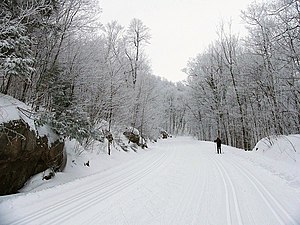
Skate skiing& involves the skier pushing one ski outward with the ski angled, so that the inner edge of the ski is driven against the snow, much like an ice skater. As in classic skiing, transferring weight completely from one ski to the next is essential to learning to skate. Those who have learned to ice skate or rollerblade may find ski skating technique easier to learn than classic skiing.
Skate skiing can be done either with skis specifically designed for skating or 'combi' skis for both skating and classic. Similarly, specialized skating boots or combi boots can be used. Skate skis tend to be shorter and stiffer than those used in classical technique, and poles longer. Neither fish scale skis nor grip wax are used.
Different limb-movement patterns are used for different terrain and speeds. Confusingly there is no internationally accepted naming convention for these techniques:
- Gear 1 (also known as diagonal V, single-poling, coach's skate or granny skate): Similar to the classic herringbone but with a short glide on each ski. This technique is hardly ever used in racing (an exception being the very steep climbs at the end of the 2007 "Tour de Ski"). As the name indicates it is often used by coaches or weaker skiers, both in training and racing.
- Gear 2 (V1, Offset Skate): Slightly off-set double-pole on every other leg. Used mostly for hill climbing.
- Gear 3 (V2, 1-Skate): Double-pole on every leg. Used on the flat or moderate uphill.
- Gear 4 (V2 alternate, Open Field Skate, 2-Skate): Double-pole on every other leg. Used on the flat or downhill.
- Gear 5 (V Skating, Free-Skate): Skating without using the poles. Used exclusively on downhills at very high speed.
There also exist variants of these techniques, most notably jump-skating, which involves extremely high tempo and jumping rather than gliding; generally it is used as a V-1 (offset skate) variant on short hills, but a few racers jump-skate in V-2 (1-skate) sprinting.
The term Alsgaard skate is often frequently used. This refers to skating in the style pioneered by Thomas Alsgaard. However, since very few skiers have successfully duplicated Algaard's technique, the term "Alsgaard skate" means different things to different people. Most often it refers to a technique he employed winning the 30 km freestyle race at the Lillehammer Olympics, where in place of a V-2 (1-skate) he used a technique that seemed to be a sort of compromise between V-1 (offset skate) and V-2 alternate (2-skate).
Skating technique is only suitable for use on prepared trails (pistes), firm and smooth snow or snow crust and frozen snow-covered lakes or rivers.
Skating is faster and different muscular exercise than classic skiing, except in extremely cold conditions where classic skiing may approach skating in speed. Adoption of the skating technique varies from country to country. In some countries the majority of non-professional racers now skate, although top skiers continue to learn and train in both styles.
The distinction between classic technique and free technique is made in competition i.e. a race will be designated as classic or free.& In the case of the former only those propulsion techniques that are considered 'classic' are allowed whereas in the latter the competitors are free to use any technique although the majority of competitors will opt to skate. Large races will often have both skate and classic divisions and award prizes in both categories.
Telemark
- Main article: Telemark skiing
The Telemark technique is particularly suited to backcountry skiing (off-piste cross-country skiing). While first and foremost it is a technique for descending, for those with dedicated equipment it is effectively a separate branch of skiing that takes place in the backcountry..
Notes
- ↑ The free technique in XC skiing is not to be confused with freestyle, which describes ski sport where the competitors compete over a mogul course and by performing aerial gymnastics such as spins after launching from a short ramp in the snow.
- ↑ Recent developments in the sport include "pursuit" races where the competitors complete the first part of the event using the classic technique and the second part using the free technique.
See also
- United States Ski and Snowboard Association
- United States Ski Team
- Skiing
- Kicksled
- Nordic Skiing
- Ski touring
- Hazards of outdoor activities
- Grass skiing
- Monoskiing
- Skwal
- Skiboarding
- Snowboarding
- Snowkiting
- Water skiing
- Sports
- Winter sport
External links
- U.S. Ski and Snowboard Association - The National Governing Body for Cross Country Ski Racing
Template:Human-powered vehicles
ar:التزلج للمسافات الطويلة ca:Esquí de fons cs:Běh na lyžích da:Langrend de:Skilanglauf et:Murdmaasuusatamine es:Esquí de fondo eo:Skikurado fa:اسکی صحرانوردی fr:Ski de fond hr:Skijaško trčanje it:Sci di fondo he:סקי למרחקים nl:Langlaufen ja:クロスカントリースキー no:Langrenn nn:Langrenn pl:Biegi narciarskie ro:Schi fond fi:Maastohiihto sv:Längdåkning zh:越野滑雪



